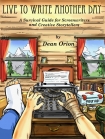Live To Write Another Day by Dean Orion (free ebooks for android .txt) 📕

Read free book «Live To Write Another Day by Dean Orion (free ebooks for android .txt) 📕» - read online or download for free at americanlibrarybooks.com
- Author: Dean Orion
Read book online «Live To Write Another Day by Dean Orion (free ebooks for android .txt) 📕». Author - Dean Orion
One of the many things I liked about Big Red One was that the NPCs (non-playing characters) in the platoon stay with you from mission to mission, shouting random commentary for the duration of the game. You also get to know a little about each one of them from brief cutscenes that take place before and after each mission, though all of this is just filler and has no impact on the actual gameplay itself.
Then, at a certain point in the middle of the game, an interesting thing happens: One of the NPC characters suddenly dies, and before you even realize what’s going on, this very somber moment occurs in which a couple of the other NPCs grieve the loss of their fallen comrade. The game then quickly transitions to the next mission without skipping a beat, and there is no mention of the event again.
I’ll never forget the feeling I had at that moment. Up until then I had been mindlessly blowing away all those Nazis for the pure pleasure of it, but now suddenly my writer gene had awoken and my thoughts were racing. What if we really got to know these guys in this platoon? What if instead of running around mission after mission doing variations of the same thing, the missions were about accomplishing objectives that mattered to your platoon mates? What if they also involved interacting with the enemy soldiers? What if you actually got to know who those guys were and all these interactions mattered? And what if there were consequences that would determine the course of the story depending on what you did and when you did it?
You see where I’m going with this? Granted, this is a shooter game, and its designers never intended for it to be about all these character-based motivations, but if you’re going to introduce characters and try to tell a story, why not make that story a sincere part of the entire experience? Why not try to fuse the interactive design as much as you possibly can with the narrative?
Even if the creators of Big Red One only went a step or two in the direction that I’m suggesting, I’m sure they could have constructed a very interesting interactive story, making what was already a very well-designed game even better.
Being a Designer/Writer
Achieving this kind of seamless marriage of gameplay and narrative requires two things. First, there needs to be a willingness on the part of game development companies to allow the stories of their narrative-based games to be created concurrently with gameplay and level design. Typically, this isn’t the case. Story details are often added much later on in the process. Second, it requires that these companies have writers working on their projects that are also skilled interactive designers. What I’m talking about now are people who not only have the writer gene, but who have the interactive gene as well.
You don’t have to be a software engineer to be a designer/writer of interactive games, but you do have to have a fundamental understanding of how games are programmed. Obviously this is a topic that is far too complex for me to go into in great detail, but I will give you a basic introduction.
The underlying principle of all interactive design is what is commonly known as the if/then scenario. In other words, if Action A occurs, then Result A happens. But if Action B occurs, then Result B happens. And from there a myriad of mind-twisting possibilities ensues.
Let’s say we’re making my version of that character-driven WWII game. One tiny slice of what would potentially be a very extensive interactive design document for that game might go something like this:
INT. BARN – DAY OR NIGHT
IF the player enters the barn, THEN they encounter STAFF SERGEANT JOHNANNES SCHMIDT.
IF the player shoots at Schmidt, THEN Schmidt yells a battle cry and engages the player in a firefight.
IF the player kills Schmidt, THEN they will find a codebook on him. But it is written in German and they must find a way to crack the code.
IF the player gets close enough to Schmidt during the encounter and hits him with the butt of their rifle, THEN Schmidt falls to the floor unconscious and they have captured him.
IF the player captures Schmidt, THEN they will find a codebook on him. The “Interrogation Interface” now appears, allowing the player to engage in conversation with Schmidt.
By opening up a series of dialogue options, the player would then unlock various elements of the meta-plot of the story, allowing them to take further actions. This could involve cracking the code in the codebook, wiping out the remaining Germans in the town, acquiring valuable intelligence critical to the larger war effort, or perhaps even forming an unexpected bond with Sergeant Schmidt that could complicate things later with the player’s platoon mates.
On the other hand, if the player kills Sergeant Schmidt, a whole other set of options and potential story paths could be opened up. Maybe there’s a revenge plot that could play out involving one of Schmidt’s comrades. Or maybe Schmidt’s uniform becomes wearable so the player can now attempt a clandestine mission behind enemy lines that they would not have been able to engage in otherwise.
You get the idea? The possibilities are endless. This is what makes designing and writing interactive games both incredibly challenging and





Comments (0)